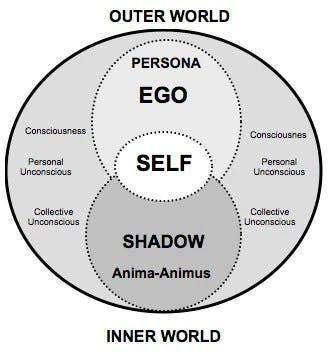Is “Love At First Sight” Real?
Today, most people think the idea of “love at first sight” is just a tired cliché. Any sort of instant connection, they argue, is simply lust and empty sexual attraction.

But what if there is some truth behind the ancient expression? What if the hopeless romantics are right, and we can instantly connect with someone…but we’re just not entirely conscious of it?
According to Swiss psychiatrist Carl Jung, there is a real psychological basis behind the common trope of “love at first sight.” Jung, the father of analytical psychology, drew upon his theory of the collective unconscious to explain this phenomenon. He regarded two concepts as vital to understanding this type of instant connection: the Anima and the Animus.

Image Credit: Typeindepth.com
The Anima/Animus Archetypes
According to Jung, the Anima is “the inner figure of a woman held by a man,” while the Animus is “the figure of a man at work in the woman’s psyche.”
Simply put, men possess a repressed feminine side (the Anima), and women possess a repressed masculine side (the Animus). The Anima and Animus lie deep in our unconscious, making up part of our repressed shadow, but they can manifest in our behavior.
Men possess a repressed feminine side (the Anima), and women possess a repressed masculine side (the Animus).
The Anima
The Anima is the personification of feminine tendencies that lives within a man’s subconscious.
Feminine energy is often associated with “emotions, tenderness, sensitivity, patience, connection with nature, and the nurturing and creative instincts.” For example, a man’s compassion, creativity, and nurturance may be expressions of his Anima.
The Anima is not only a personal complex, but the archetypal image of a woman within a man’s psyche. This image forms in childhood, at first associated with the personal mother, and then later experienced in other women. It’s unique to each man, and can range from a virginal figure to a sexual diva.
A man’s compassion, creativity, and nurturance may be expressions of his Anima.
Jung held that there are four levels of Anima development in men, which he named Eve, Helen, Mary, and Sophia. As men mature spiritually and open up emotionally, they move through the following stages of development:
Eve: Referring to the Genesis story of Adam and Eve. Here, women are associated with nourishment, security, and love. Men at this stage of development struggle to function without an intimate female relationship, are often controlled by their partner, and are uninterested in sexual relations.
Helen: Referring to Helen of Troy in Greek mythology. In this phase of Anima development, women are viewed as self-reliant and intelligent, but are not necessarily seen as virtuous.
Mary: Named after the Virgin Mary. In this phase, women are seen as virtuous and activities thought of as unvirtuous can’t be applied to them.
Sophia: Named after the Greek word for wisdom. This phase signals complete integration of the Anima. Men at this level of development regard women as individuals who possess both positive and negative qualities.
The Animus
By contrast, the Animus is the personification of masculine tendencies within a woman’s psyche.
Masculine psychic energy is typically characterized by rationality, logic, assertiveness, intention, and outward action. For example, a woman’s assertiveness, the strength of her conviction, and her ambition may be an expression of her Animus.
A woman’s assertiveness and her ambition may be an expression of her Animus.
Women also possess an archetypal image of a man, characterized by four levels of development:
Man of mere physical power: Such as an athletic champion or muscular man, personified by the fictional hero Tarzan.
Man of action or romance: Here, the archetypal man has the capacity for planned action (e.g. a war hero or hunter) or romance (e.g. Ernest Hemingway)
Man as an orator/professor: The Animus becomes the “bearer of the word,” (e.g. a political orator).
Man as a spiritual guide: In this final phase, the Animus becomes the “incarnation of meaning” and a “mediator of...spiritual profundity” (e.g. Hermes, the messenger of the gods).
Love at First Sight
So what does the Anima/Animus archetype have to do with romance?
Well, Jung believed that we choose our partners based on how closely they resemble our Anima or Animus. This is the psychological basis behind “love at first sight,” or, as the Greeks put it, theia mania (madness from the gods).
As Jung wrote, “When animus and anima meet, the animus draws his sword of power and the anima ejects her poison of illusion and seduction. The outcome need not always be negative, since the two are equally likely to fall in love (a special instance of love at first sight).”
Love at first sight is the feeling of instantly knowing that someone fits our Anima or Animus archetype.
And so, when we’re looking for a partner, we’re essentially “looking for our other half, the half that the Gods took from us, in members of the opposite sex.” Love at first sight is therefore the feeling of instantly knowing that someone fits our Anima or Animus archetype.
“The [anima] archetype is a force, it has an autonomy,” Jung believed. “Falling in love at first sight… You see, you have a certain image in yourself without knowing it of…the woman. Now you see that girl, or at least a good imitation of your type, and instantly…you’re caught.”
When the Anima and Animus meet, they form Syzygy. Syzygy means a “union of opposites,” representing what clinical psychologist Carolyn Kaufman calls “the same kind of cohesive whole Plato described when the two halves of sundered humans wrap their arms around one another once again become one.”
Do Opposites Attract?
The Anima/Animus archetype also implies the truth behind another romantic cliché: that opposites attract.
In many ways, the Anima/Animus is “the inversion of the persona” (the version of ourselves that we display to the public world). We are therefore attracted to those who “outwardly express characteristics and feelings that lay dormant in [our] own psyche.” For example, a woman’s Animus is her suppressed masculine energy (the opposite to her public feminine side).
We tend to look for partners with complementary strengths and weaknesses so we balance each other out.
Subconsciously, we’re attracted to those who closely resemble our repressed side — the opposite of our public personality. For example, hyper-masculine men are often attracted to hyper-feminine women, because they represent the Anima within their unconscious psyche — that missing part of themselves. This is beneficial as we tend to look for partners with complementary strengths and weaknesses so we balance each other out.
How To Get in Touch with Your Anima/Animus
Some people have a healthy and integrated Anima/Animus. Typical qualities of an integrated Anima include being empathetic, happy, nurturing, and loving. A man with a displaced Anima may instead become greedy, self-centered, uncreative, moody, and unconstrained. You can also tell the level of a man’s Anima development by how he relates to women.
Jung believed that younger men can “bear even the total loss of the Anima without injury... the important thing at this stage is for a man to be a man.” However, the permanent loss of the Anima as an adult man may lead to a “diminution of vitality, of flexibility, of human kindness,” manifesting in traits like rigidity, sloppiness, irresponsibility, and a childish tendency to alcohol.
Women with an integrated Animus tend to be rational, problem-solving, and have a strong center. A displaced Animus may instead result in “know-it-all” behavior, loudness, bullying behavior, and an inability to properly relate to others.
So, how do we connect with and integrate our Divine Feminine side (Anima) or our Divine Masculine side (Animus) into our conscious lives?
Well, we have to connect with our opposites. For example, a woman can connect with her Animus by practicing assertiveness training, while a man can get in touch with his Anima by expressing himself creatively or nurturing something.
By connecting with our Anima/Animus and making these aspects conscious, we attain wholeness.
By connecting with our Anima/Animus and making these aspects conscious, we attain wholeness. This means a healthy balance between our masculine and feminine energies. Jung believed that integrating our Anima/Animus is a vital part of what he called “individuation” or “self-realization.”
But while we shouldn’t repress our Anima/Animus, we should also be wary of possession by it. For example, Jung would regard extremely argumentative women as a manifestation of possession by the Animus. By contrast, a man who is possessed by irrational and uncontrollable emotions may be an example of possession by the Anima.
How To Use Anima/Animus Archetypes in Your Love Life
If you’re single and looking for love, connecting with your inner Anima/Animus could help you to seek out the right complementary partner.
Start by reflecting on the dreams and visions you have of the opposite sex. Reflect on those qualities you regard positively in the opposite sex, whether it’s characteristics within your parents, siblings, or romantic partners. From here, you can figure out what level of Anima/Animus development you’re at.
For those who are in loving, long-term relationships, it’s also helpful to regularly reflect on what makes your partnership work and how the two of you complement one another, so you can continue to strengthen that bond.
Marriage is the “single most effective tool to integrate the soul image.”
The most effective way to better understand your Anima/Animus is to commit to a mature and long-term relationship with the opposite sex, typically in the form of marriage. Jungian analyst Stephen Farah believes that marriage is the “single most effective tool to integrate the soul image.” Children raised in a loving marriage will also have a healthy model from which to form their archetypal images of the feminine and the masculine.
Closing Thoughts
Whether you’re in a happy relationship or looking for love, take time to reflect on your inner Anima/Animus, how it affects your behavior, and how you can strive for greater wholeness. By looking at your own habits, you may be able to bring lost aspects of yourself to the fore, and figure out exactly what you need in a complementary partner.
Ultimately, not every romantic cliché is simply lust or sexual attraction. At a subconscious level, it seems we really are looking for our other half, making it possible to feel that instant connection. Finding real, committed love is an important part of life, not only for comfort and support, but because in finding our soulmate we reunite the lost aspects of ourselves and fall in love with our inner soul.